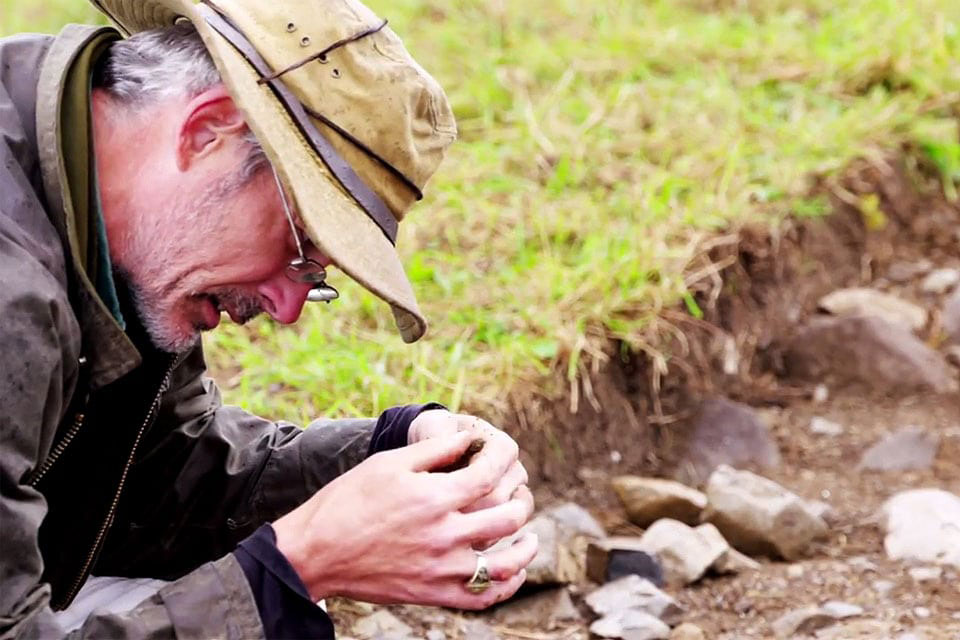SLU Professor, Students Seek the Irish Past in New Documentary
For Saint Louis University historian and archaeologist Thomas Finan, Ph.D., digging into the past buried in layers of Irish soil is a means to understand the past and to prepare his students for the future. A new documentary from HEC-TV chronicles that journey and will premiere at Saint Louis University on Sept. 28.
In True Gaelic: Unearthing Medieval Ireland, HEC-TV cameras and crew follow Finan, associate professor of history and director of SLU's Walter J. Ong, S.J. Center for Digital Humanities, and his students on a first-ever excavation on the shores of Lough Cé in County Roscommon, Ireland. The premiere is open to the public and the SLU community.
The documentary's Sept. 28 premiere will take place at SLU's Center for Global Citizenship, with doors set to open at 6:30 p.m. An evening of Irish dancing, music and free refreshments will lead up to the documentary's screening and complimentary parking will be available in the Laclede Garage.
Finan’s research centers on 13th century Gaelic Ireland, which refers to the part of the island not subject to English control after England’s conquest of Ireland in the late 12th century. Finan studies the history and archaeology of north County Roscommon, where there was a great deal of cultural and political strife between the native Irish and English.
Finan has been working on the Lough Cé project with Jim Schryver, Ph.D., of the University of Minnesota-Morris, Alan Hayden, an Irish archaeological contractor and Kieran O’Conor, Ph.D., of the National University of Ireland in Galway.
He first visited Lough Cé in 1987.
“I have loved it ever since,” Finan said. “I really can’t put it into words, but when you visit or look at photos of Castle Island on Lough Cé, you see what I mean.”
HEC-TV’s Dennis Riggs heard about Finan’s work during a meeting hosted by Kevin O’Malley (A&S ’70, Law ‘73), the ambassador to Ireland.
“We kept the conversation going,” Finan recalled. “All the pieces were there to do a great production. The documentary crew filmed the Lough Cé dig during the summer of 2016.
Working with a film crew was new for Finan and benefited the project, he said, because the questions the crew posed in order to make sense of the excavation work turned out to be “a good exercise in being a little more obvious and thoughtful about what we were doing, and how we were presenting information as we progressed.”
About 10 SLU students joined Finan on the dig, where they dug into layers of Irish soil that took them back through history. The site was used or occupied from as early as the 8th century and fell out of use around the 1600s.
Finan’s students had an opportunity to put their SLU educations to use in a way that spanned disciplines, he said.
“The benefit to students working on such a project is that they gain real and practical field experience working on a complicated research project,” Finan said. “Each individual student does everything on site, from hard core excavation, to cataloguing finds, to surveying, to drafting, to landscape analysis. In a sense, it is really the best sort of interdisciplinary research project.”
I have loved it ever since. I really can’t put it into words, but when you visit or look at photos of Castle Island on Lough Cé, you see what I mean."
Thomas Finan, Ph.D.
Finan said his favorite moments were when students realized that they were, in a sense, going back in time.
“The moment that a student hits something significant for the first time, and we have to shift from moving sod off the surface to making students realize that they are digging in the 14th or 13th century,” he explained, “that’s always an exciting moment.”
Those moments also speak to the Jesuit mission that Finan and his students live through their explorations of the Irish past.
“We are called to interact with other people and understand ‘the other’,” Finan said.“I often say to students that history and archaeology are no different in that we are always trying to understand the perspective of other people.” That quest for understanding continues even when those people have only left behind ruins and fragments on the shores of an Irish lake.
Saint Louis University is a world-class Catholic, Jesuit institution educating nearly
13,000 students on two dynamic, urban campuses - in St. Louis, Missouri, and Madrid,
Spain. Founded in 1818, the University will soon celebrate its bicentennial.
With a legacy of innovative academics and research, compassionate health care and
faithful service, Saint Louis University attracts a diverse community of scholars
who push intellectual boundaries in pursuit of creative, meaningful ways to impact
the world, striving to serve a higher purpose and seek a greater good.


















